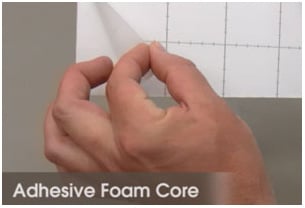Foamcore or Foamboard is a strong and lightweight material that is easily cut with either a specialist tool like the Foamwerks Straight or Bevel Cutter, a sharp craft snap off knife or the straight head of a picture framing mat cutter.
Sometimes it is cut on a CNC type cutting machine or die cut when it needs to be a special shape or custom size.
It is used for signage, printing and mounting of prints and photographs and as backing in picture frames.
The material is great for craft work, as a substrate for stretching needleworks or other fabrics.
Aero-modelers use the foam core sheets to construct RC model airplanes.
Railway enthusiasts can made scenic displays and other items for their model railroads.
Foam core board is easily shaped for use in designing interior designs and architectural models.
Foamcore consists of three layers, an inner layer of fine celled polystyrene that is clad with white clay coated paper, cotton archival paper or common brown Kraft paper. It also is available in a black cored and surfaced variety.
For picture framing use we recommend the acid-free alpha cellulose clad boards as they have a longer lifespan and do not leach acids into the artworks. In high end conservation framing a further barrier of cotton rag boards or alpha-cellulose boards should be placed between the foam board and the original artwork. For more details on conservation framing and the Endurart Process please download a free PDF brochure here.
Since 1957 foam core board was made in 1/8 inch (3 mm) and 3/16 inch (5 mm) thicknesses by Monsanto under the trade name of Fome-Cor®
It has now become a popular backing in picture framing, with archival-quality variants now available from several manufacturers.
Thicknesses from 3mm to 10mm are commonly available and a 20mm version is available for construction of large displays and art mounting applications.
There are other foam cored materials produced under various brand names that have a cladding of solid styrene or other rigid plastic coating. These are useful for signage and for situations where rigidity is required. Normally these boards are cut using a panel saw.
Some specialised boards are made with aluminium facing to allow mounting of high gloss photographic prints and some are made with fire-retardants for use in museum situations.
Clay-coated Foamcore does not accept certain types of paint and some glues, such as superglue is not suitable for bonding. Solvents used in some paints and glues can dissolve the foam centre causing weakness and the breakdown of the structural integrity of the foamboard.
Water-based glues can warp the fibers in the outer layers upon drying causing warping so adhering a layer to the reverse side can minimise this issue. Best results are typically obtained from using double sided adhesive sheets or use our pre-coated self-adhesive foamboard if you wish to “drymount” your prints and photographs.

Self-adhesive foam boards are used for mounting images by peeling a release film and then applying the image to the surface usually from one end smoothing as you go.
It id best used when run through a mounting roller to apply the print but it can be used successfully at home or without special equipment if care is taken to mount the image smoothly.
After you have mounted your photograph or print onto self-adhesive foam core you should keep the mounted work flat to ensure it does not warp before you assemble the image in a picture frame or apply other hanging devices.
For temporary mounting applications use plain foam core and then apply re-positionable spray adhesive to one of the surfaces, either the back of the image or the face of the board.
For more information and to buy the product in Australia please go here.
